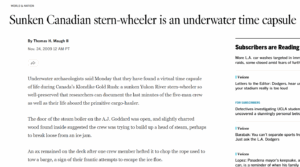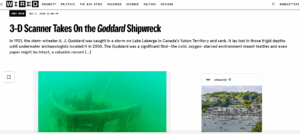Excerpts:
Underwater archaeologists said Monday that they have found a virtual time capsule of life during Canada’s Klondike Gold Rush: a sunken Yukon River stern-wheeler so well-preserved that researchers can document the last minutes of the five-man crew as well as their life aboard the primitive cargo-hauler.
…“Goddard is a very important reminder that ordinary people get caught up in events that are bigger than themselves. It’s a rare window into the past where we can truly connect with these five guys, the reality of the gold rush and trying to make a go of it in difficult times,” Delgado said.
Excerpt:
The Yukon government has designated the A.J. Goddard, a Gold Rush-era steamboat found on the bottom of a lake last year, a historic site.
This means the shipwrecked sternwheeler, which remains almost intact at the bottom of Lake Laberge, will be protected from damage or harm by people, according to Yukon government officials.
“We’re delighted to see the designation because it shows that not only are shipwrecks important pieces of the past, but that they’re also important resources,” James Delgado, the Texas-based president of the Institute of Nautical Archeology, told CBC News.
Excerpts:
In 1901, the stern-wheeler A. J. Goddard was caught in a storm on Lake Laberge in Canada’s Yukon Territory and sank. It lay lost in those frigid depths until underwater archaeologists located it in 2008. The Goddard was a significant find—the cold, oxygen-starved environment meant textiles and even paper might be intact, a valuable record of the Klondike Gold Rush. Standard procedure for mapping such a wreck used to involve fiberglass tape and sketches on Mylar, a tedious process fraught with error—highly accurate surveys could take years.
…In an afternoon, the team created a hi-res digital Goddard, “right down to the mud on the sides,” INA president Jim Delgado says.
Excerpt:
Just months after a team of archeologists revealed their discovery of a historic Klondike shipwreck in waters north of Whitehorse, the Yukon government has declared the sunken A.J. Goddard sternwheeler a historic site symbolizing the “sense of adventure” that gripped North America at the height of the 1890s gold rush.
In November, famed Canadian wreck hunter James Delgado, his colleague, John Pollack from the Texas-based Institute of Nautical Archaeology, and Yukon museum curator Doug Davidge announced they’d located the “perfectly preserved” Goddard in fabled Lake Laberge, a widening of the Yukon River that served as a key transportation route for gold-seekers in the 1890s.
Excerpts:
The exact location of the 108-year-old sternwheeler A.J. Goddard had been a mystery since Oct. 22, 1901, when it vanished in Lake Laberge during a winter storm. Two members of the five-man crew survived, while the other three drowned.
…”There was a blacksmith’s forge with tongs, tools spilled out along the deck and on the bottom, an anvil, and where one man had obviously struggled to get free, his coat and boots [were] lying right there on the deck,” Delgado said.
Excerpts:
A team of international archeologists hunting for a relic of the Klondike gold rush has hit pay dirt at the bottom of Lake Laberge, a dark and frigid Yukon waterway immortalized by Robert Service.
The A.J. Goddard, the first steamer ever to reach Dawson City, the hub of the famous gold rush, has been found in near perfect condition 108 years after it sank on Oct. 22, 1901.
…”A lot of this wouldn’t have happened without his perseverance,” said Jim Delgado, president of the Institute of Nautical Archaeology.





